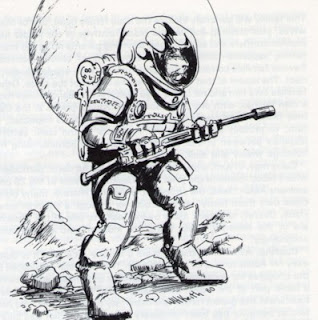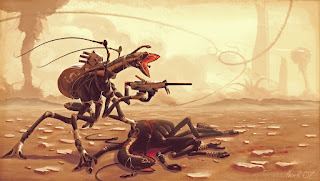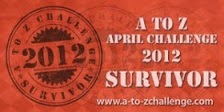 The Veil - created by the passage of a starcluster through the plane of the galaxy some 100,000 years ago, the Veil stretches up out of the plane of the galaxy, originating in the Spinward March / Trojan Reach section of published maps, and trailing up towards the open starcluster.
The Veil - created by the passage of a starcluster through the plane of the galaxy some 100,000 years ago, the Veil stretches up out of the plane of the galaxy, originating in the Spinward March / Trojan Reach section of published maps, and trailing up towards the open starcluster.- Chris Harrod:
MetaTravellerThe creation of the Veil by my friend Chris enabled us to sidestep the increasing clutter around the Spinward March, while still permitting us to use interesting “official” material without too much trouble. The divergence of our campaigns into the Veil was the beginning our divergence from the GDW-driven timeline of the 3rd Imperium, though the on-going campaign development jumped backwards and forwards chronologically, as well as moving from the macro metagame to the micro scenario.
Writing up the Imperial History of the RimWorlds in 2008, I began to flesh out my theories of a comitatus-style development of the RimWorlds and the character of that initial swashbuckler, Kolin Venuraski, started to emerge:
History of the RimWorlds103 Thongaloros Empire falls to the Outrim Barbarians.
323 Ftaioiaftew/Gazul settled by Aslan of Huiha Weakhayuwikhye.
497 First Imperial presence in the Rimworlds in Kaorin and Berimar’s Sceptre subsectors.540 Sector Duchy of the Rimworlds established with its capital on Raelmar/Thurgandarn. Kolin I Venuraeki is first Sector Duke.
The Imperial Interstellar Scout Service mapped their way up the Whisp and into the Coreward Subsectors of Kaorin and Berimar’s Sceptre in the mid-490s. The Whisp Route was, by its nature, difficult to navigate with the Tech Level 12 equipment available to the Imperium at that time. Several Rifts, with multiple, barely sustainable, Jump-3 passages across them, challenged the Scout Service Exploration Service. Eventually, massive fuel refineries orbiting sullen and isolated M-Class stars kept the route open.
Having run the Whisp, the Scouts discovered that the Coreward Subsectors of the RimWorlds, Kaorin and Berimar’s Sceptre, possessed a relatively dense population of vibrant, younger stars, perhaps remnants of the original starcluster that burst through the disc of the Milky Way some 100,000 years earlier. Unlike the barren stars of the Whisp, these stars possessed planetary systems rich in resources.
As the exploration reports filtered back to the IISS Domain Command Centre Deneb, Lord Kolin Venuraski, the young, ambitious, head of a cadet branch of the House of Deneb, caught wind of this new and, as yet, unexplored region. Deftly manoeuvering through the rocks and eddies of Domain Court politics, Lord Kolin, the younger son of Count Metch Venuraski of Fornice/Mora, succeeded in having himself appointed to head the Imperial Commission considering the Scout Service reports on the new sector.
As the Imperium was already heavily committed to the exploration and settlement of the Spinward March, the prospects of colonising a remote pocket of space, accessed via a hazardous and difficult passage, held no immediate attraction to the members of the Commission. Except for Lord Kolin Venuraski. Proposing to explore and exploit the RimWorlds for the betterment of the Imperium through the agency of a Chartered Private Equity Company, thus avoiding any direct commitment of sparse Imperial resources, Lord Kolin shamelessly exploited his position as Head of the Imperial Commission to be commissioned Viceroy of the RimWorlds Sector. The patent of Viceroy was struck in 525, 28 years after the initial scouting missions.
Venuraski had not been idle during this time. Early on, he had reached the conclusion that the Imperium or, more specifically the Domain of Deneb, with expansion in the Spinward March under way, lacked the resources to fully exploit the Rimworlds. In his capacitiy as Head of the Imperial Commission, he was able to ensure that the Scout Service purchased refinery stations for the Whisp Route that vasty exceeded the Service’s requirements. That a large percentage of the refinery construction work was farmed out to heavy engineering corporations on Fornice, or in the Mora Subsector with connections to House Venuraski, passed unnoticed at the time.
As the Imperial Commission’s deliberations dragged on, Venuraski put together a team of trusted advisors who analysied the confidential Scout Service reports and then began drawing up a colonisation plan for the RimWorlds. With this plan in hand, Lord Kolin began marshalling the resources of his immediate family and his wider House. A casual conversation at a soiree opened his eyes to the fact that there were a number of younger siblings of the Houses Major who felt that they were being excluded from the Spinward March development. Frustrated, yet in control of reasonable resources in their own names, these restless young nobles numbered talented, yet untested, members amongst their ranks.
By the time Lord Kolin became Viceroy Kolin of the RimWorlds in 525, he had a strong, multitiered organisation behind him. The moneyed timid, as well as the short-changed adventurer, had all found places in his Chartered Private Equity Company, as silent shareholders or as divisional chiefs and managers. The first colonies were already established in Thurgandarn Subsector in the Coreward RimWorlds even as the ink dried on Kolin Venuraski’s letter patent as Viceroy.
Expansion was rapid and successful, and Kolin began to dream of a Sector Duchy. And then his advancing wavefront of scouts ran into a technologically competent Pocket Empire, the Klarthur Confederacy.








































.png)








